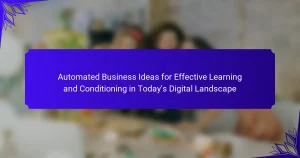Enhancing learning and conditioning is crucial for effective education. This article explores how technology personalizes learning experiences, how neuroscience reveals brain adaptability, and how mindfulness improves focus. It examines immersive environments like virtual reality, adaptive learning platforms, and mindfulness techniques that foster cognitive flexibility. By integrating these elements, educators can create a holistic framework for deeper understanding and improved educational outcomes.
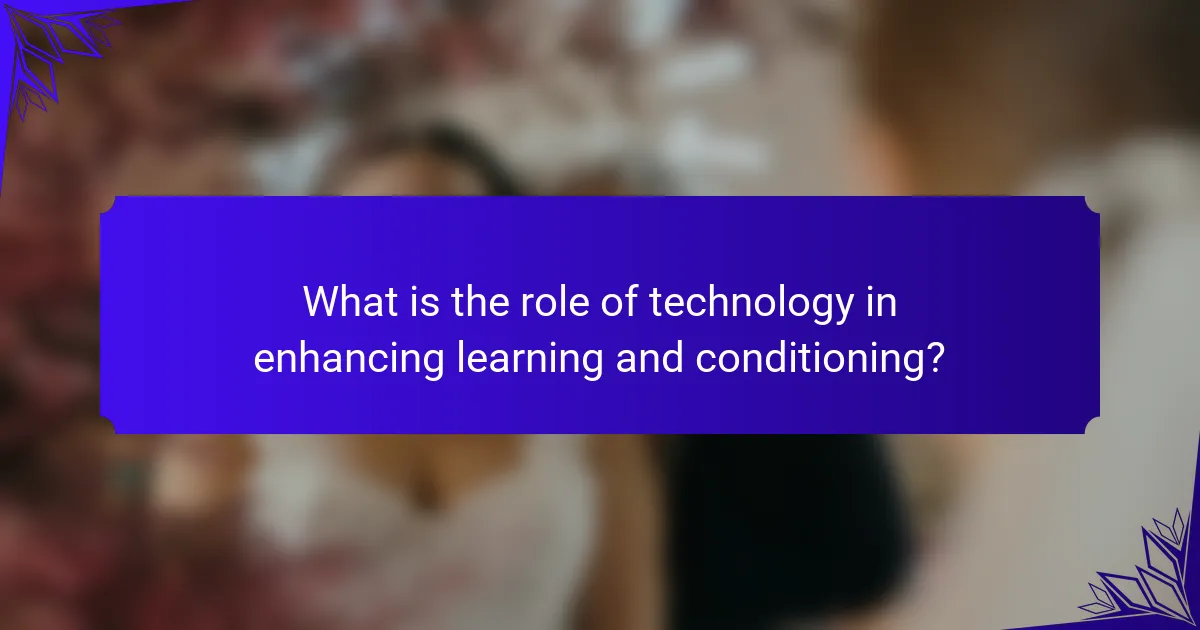
What is the role of technology in enhancing learning and conditioning?
Technology plays a crucial role in enhancing learning and conditioning by integrating neuroscience and mindfulness techniques. It facilitates personalized learning experiences, enabling better engagement and retention. Adaptive learning platforms utilize data analytics to tailor educational content, catering to individual needs and learning styles. Virtual reality and gamification create immersive environments that enhance motivation and practical skill development. Additionally, mindfulness apps promote mental well-being, improving focus and reducing anxiety, which supports effective learning.
How do digital tools facilitate personalized learning experiences?
Digital tools enhance personalized learning experiences by adapting content to individual needs. These technologies utilize data analytics and artificial intelligence to tailor educational materials, ensuring engagement and effectiveness. For example, platforms can assess learning styles and pace, adjusting resources accordingly. This unique attribute of adaptability fosters deeper understanding and retention. As a result, learners achieve better outcomes through customized pathways that align with their goals and preferences.
What are the key features of adaptive learning platforms?
Adaptive learning platforms feature personalized learning experiences, real-time data analytics, and interactive content. These platforms utilize algorithms to tailor educational paths based on individual progress and learning styles. They enhance engagement through gamification and adaptive assessments that adjust difficulty levels. Additionally, they often incorporate multimedia resources to cater to diverse learning preferences, fostering a more effective and inclusive educational environment.
How can gamification boost engagement in learning?
Gamification significantly boosts engagement in learning by integrating game-like elements into educational experiences. This approach enhances motivation, fosters competition, and encourages collaboration among learners.
Gamification leverages technology to create interactive environments that stimulate interest and participation. Features such as points, badges, and leaderboards provide immediate feedback, reinforcing positive behaviors. As a result, learners are more likely to persist in their studies, leading to improved retention and understanding of material.
Research indicates that gamified learning experiences can increase engagement rates by up to 60%. This unique attribute highlights how gamification transforms traditional learning methods into dynamic, enjoyable experiences that resonate with diverse learners.
Incorporating mindfulness into gamification can further enhance focus and reduce anxiety, creating a holistic approach to learning. This rare combination of elements not only boosts engagement but also supports overall well-being in educational settings.
What impact does artificial intelligence have on educational methods?
Artificial intelligence significantly enhances educational methods by personalizing learning experiences. AI-driven tools analyze student data to tailor content, pacing, and feedback, improving engagement and retention. For instance, adaptive learning platforms adjust difficulty based on real-time performance, fostering a more effective learning environment. Additionally, AI facilitates access to resources, enabling students to explore subjects at their own pace. This technology not only supports diverse learning styles but also promotes mindfulness by allowing learners to focus on their unique educational journeys.
What are the benefits of AI-driven learning analytics?
AI-driven learning analytics enhance educational experiences by providing personalized insights into student performance. These analytics enable educators to identify learning patterns and adapt teaching strategies effectively. As a result, students receive targeted support, improving their engagement and outcomes. Unique attributes of AI-driven analytics include real-time feedback and predictive modeling, which help in anticipating learning needs and tailoring interventions. This technology fosters a data-informed culture in educational institutions, ultimately leading to more effective learning environments.
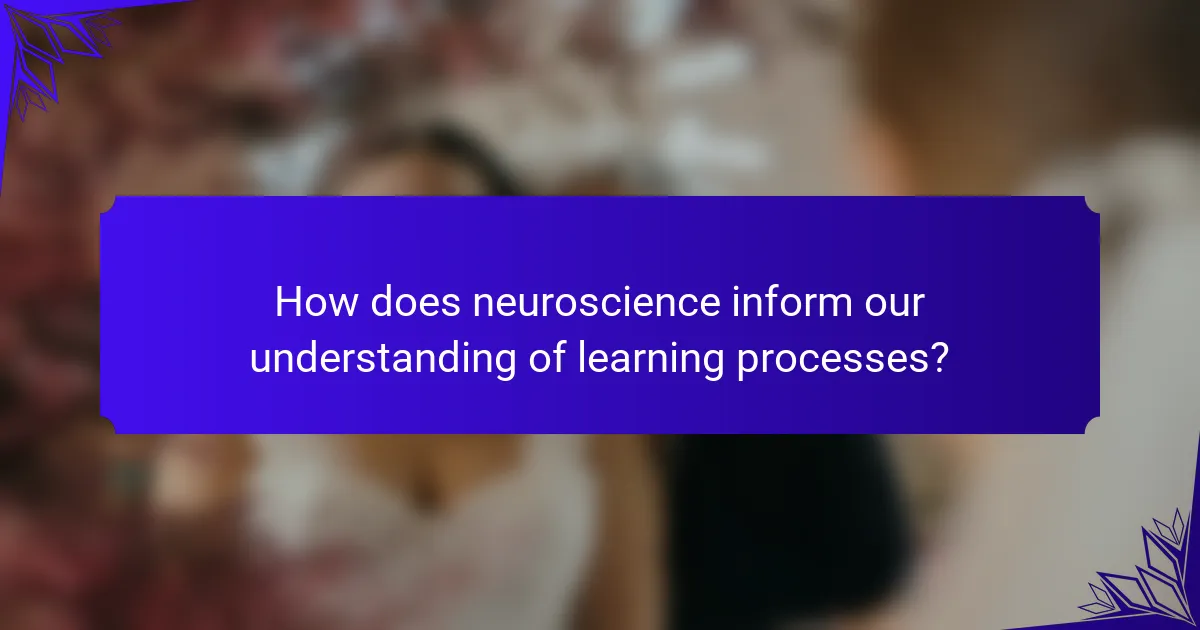
How does neuroscience inform our understanding of learning processes?
Neuroscience enhances our understanding of learning processes by revealing how the brain adapts and changes through experience. It identifies neural pathways involved in conditioning, demonstrating that technology and mindfulness can optimize these pathways. Research shows that engaging with technology can stimulate brain activity, improving memory retention and learning efficiency. Additionally, mindfulness practices have been linked to increased focus and cognitive flexibility, further supporting effective learning strategies. This integration of neuroscience with educational methods fosters a more profound and effective learning experience.
What are the neurological bases of conditioning?
The neurological bases of conditioning involve the brain’s ability to form associations between stimuli and responses. Key structures include the amygdala, which processes emotional responses, and the hippocampus, essential for memory formation. Neurotransmitters like dopamine play a crucial role in reinforcing behaviors. Studies show that technology can enhance these processes by providing real-time feedback, improving learning outcomes. Mindfulness practices also influence conditioning by promoting awareness and focus, leading to better retention and application of learned behaviors.
How do neurotransmitters affect learning and memory?
Neurotransmitters significantly influence learning and memory by facilitating communication between neurons. Key neurotransmitters like dopamine enhance motivation and reward processing, while glutamate is crucial for synaptic plasticity, a fundamental mechanism underlying learning. Research shows that balanced neurotransmitter levels improve cognitive functions and memory retention. For example, increased dopamine levels can enhance the acquisition of new information, while serotonin contributes to mood regulation, indirectly affecting learning capabilities.
What insights does brain plasticity provide for educators?
Brain plasticity offers educators insights into personalized learning strategies. Understanding brain adaptability helps tailor teaching methods to individual student needs. This approach enhances engagement and retention, fostering a growth mindset. Incorporating technology and mindfulness practices can further optimize learning experiences, promoting emotional regulation and cognitive flexibility. Research shows that targeted interventions can increase academic performance by leveraging neuroplasticity principles.
How can neurofeedback enhance learning outcomes?
Neurofeedback enhances learning outcomes by optimizing brain function, improving focus, and increasing retention. This technology provides real-time feedback on brain activity, allowing learners to develop self-regulation skills. As a result, individuals can achieve a heightened state of awareness and concentration, which is crucial for effective learning. Studies indicate that neurofeedback can lead to improved academic performance and cognitive flexibility, making it a valuable tool in educational settings.
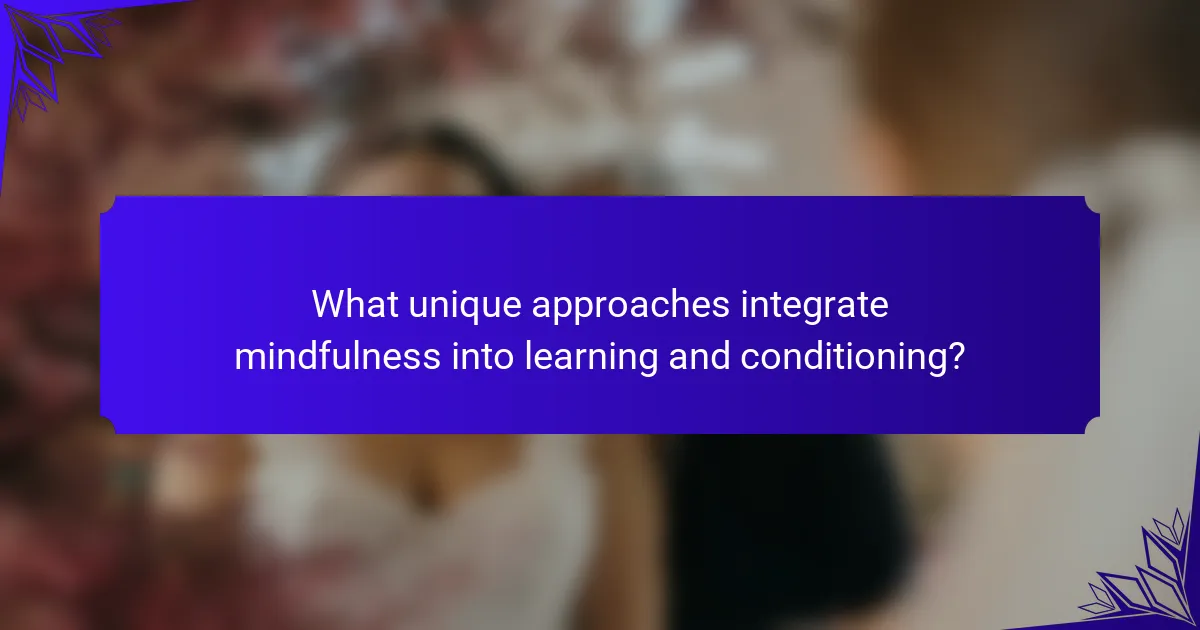
What unique approaches integrate mindfulness into learning and conditioning?
Mindfulness enhances learning and conditioning through unique approaches like immersive technology, neurofeedback, and integrated meditation practices. These methods foster deeper engagement and cognitive flexibility, allowing learners to develop self-awareness and emotional regulation. For example, virtual reality environments can simulate real-life scenarios, promoting experiential learning while mindfulness techniques enhance focus and retention. Additionally, neuroscience research supports the efficacy of mindfulness in improving attention spans and reducing stress, which are crucial for effective learning.
How does mindfulness improve focus and retention in learners?
Mindfulness significantly enhances focus and retention in learners by promoting present-moment awareness and reducing distractions. Practicing mindfulness improves cognitive flexibility, enabling learners to adapt their attention effectively. Neuroimaging studies show that mindfulness increases gray matter density in brain regions associated with memory and learning. As a result, learners exhibit better information retention and improved academic performance.
What techniques can educators use to incorporate mindfulness practices?
Educators can incorporate mindfulness practices through techniques such as guided meditations, breathing exercises, and mindful movement activities. These approaches enhance focus and emotional regulation, promoting a conducive learning environment. For example, integrating short mindfulness sessions before lessons can improve student engagement and reduce anxiety. Additionally, utilizing technology like mindfulness apps can provide structured support for both educators and students, making practices accessible and engaging.
What are the psychological benefits of a mindful learning environment?
A mindful learning environment enhances psychological well-being by reducing stress and improving focus. This approach fosters emotional regulation, promoting resilience and self-awareness. Studies indicate that mindfulness practices can lead to increased cognitive flexibility and creativity, vital for effective learning. Additionally, such environments encourage collaboration, enhancing social connections and support networks among learners.
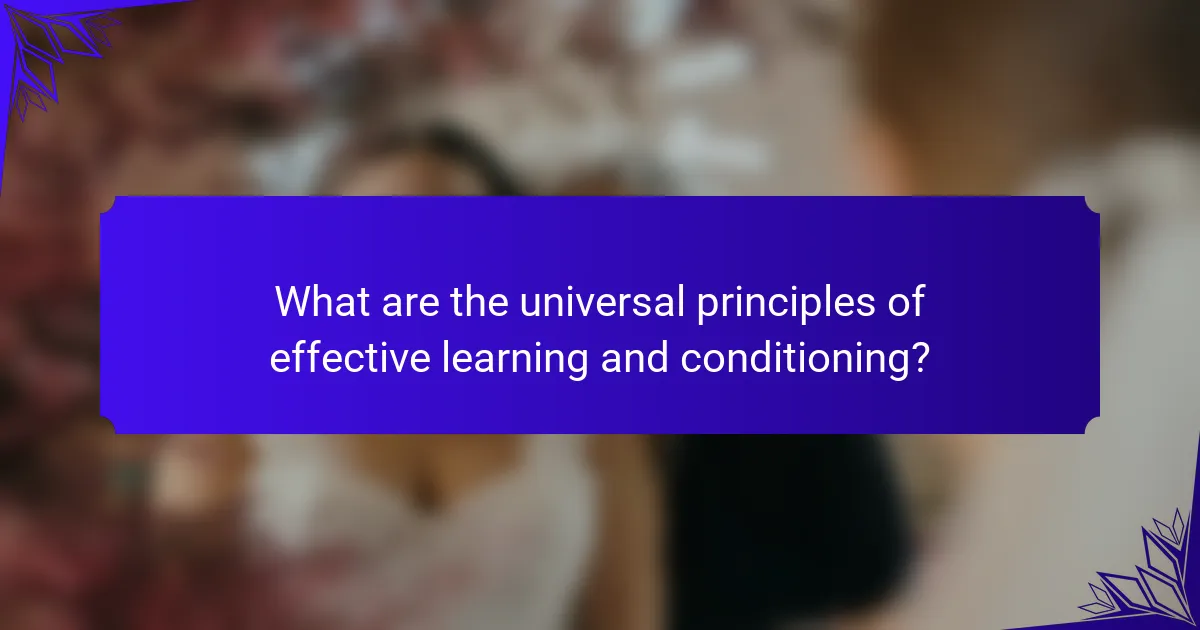
What are the universal principles of effective learning and conditioning?
Effective learning and conditioning rely on principles such as engagement, feedback, and adaptability. Incorporating technology enhances these aspects by providing personalized experiences. Neuroscience emphasizes the importance of neuroplasticity, allowing learners to adapt and grow. Mindfulness fosters focus and retention, creating a conducive environment for learning.
What strategies promote active learning and engagement?
Active learning and engagement are promoted through strategies that integrate technology, neuroscience, and mindfulness. Utilizing interactive tools enhances participation, while neuroscience insights inform effective teaching methods. Mindfulness practices foster focus and retention, creating a holistic learning environment. These approaches collectively enhance conditioning and deepen understanding.
How can collaboration enhance the learning experience?
Collaboration enhances the learning experience by fostering engagement, improving retention, and encouraging diverse perspectives. It allows learners to share knowledge, which deepens understanding and promotes critical thinking. Collaborative environments can leverage technology, neuroscience, and mindfulness to create more effective learning conditions. For example, studies show that group work can increase motivation and accountability among learners, leading to better outcomes.
What role does feedback play in the learning process?
Feedback is crucial in the learning process as it provides guidance, reinforces understanding, and enhances motivation. It enables learners to recognize their strengths and areas for improvement, fostering a growth mindset. Incorporating technology and neuroscience can optimize feedback delivery, making it more immediate and personalized. Mindfulness practices can further enhance receptivity to feedback, promoting deeper learning and retention. This holistic approach to feedback not only improves conditioning but also supports overall cognitive development.
What types of feedback are most effective for learners?
Effective feedback for learners includes timely, specific, and actionable insights that promote growth. Technology enhances feedback through instant assessments, while neuroscience highlights the importance of emotional engagement. Mindfulness practices can increase receptiveness to feedback, fostering a positive learning environment.
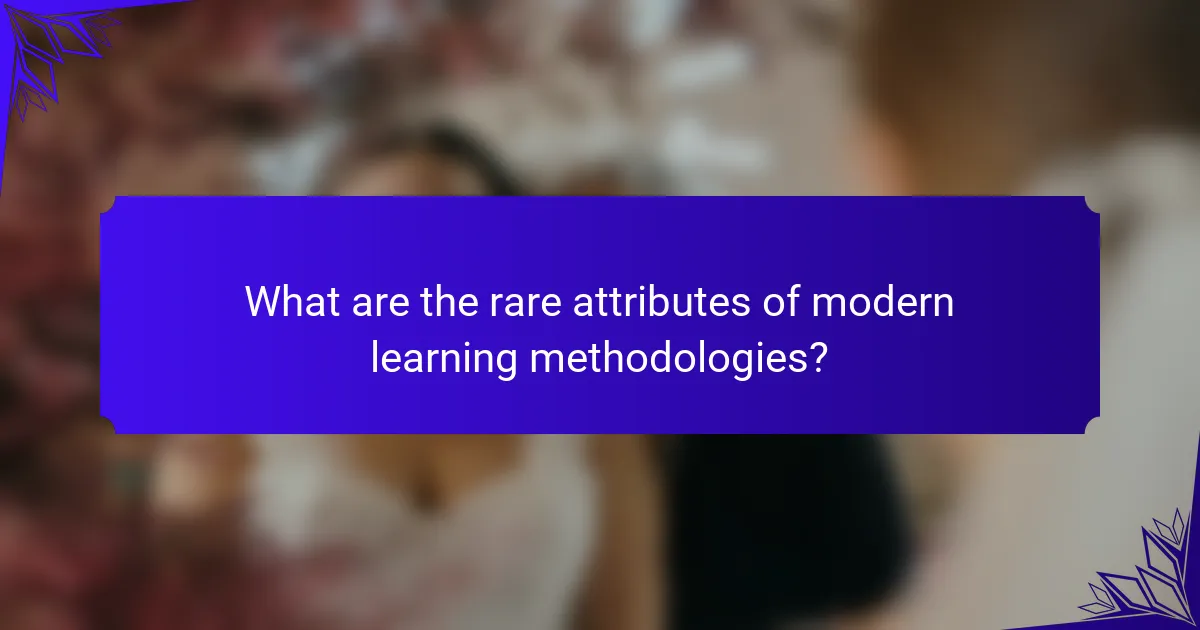
What are the rare attributes of modern learning methodologies?
Modern learning methodologies exhibit rare attributes that enhance engagement and retention. These include immersive experiences through virtual reality, personalized learning paths driven by AI, and the integration of mindfulness practices to improve focus. Additionally, methodologies that leverage neuroscience insights to optimize cognitive load and memory retention stand out. These attributes contribute to a more holistic and effective learning experience, fostering deeper understanding and application of knowledge.
How do cultural contexts influence learning styles?
Cultural contexts significantly shape learning styles by influencing how individuals process information. For instance, collectivist cultures often emphasize collaborative learning, while individualistic cultures may prioritize self-directed approaches. Technology enhances these dynamics by providing diverse methods tailored to cultural preferences. Neuroscience reveals that cultural background affects cognitive functions, which in turn influences learning effectiveness. Mindfulness practices, rooted in various cultures, can further enhance focus and retention, adapting to different learning environments.
What unique challenges do diverse learners face?
Diverse learners face unique challenges that hinder their educational progress. These challenges include varying learning styles, cognitive processing differences, and emotional regulation issues. Technology can enhance learning by providing tailored resources that address these diverse needs. Neuroscience shows that understanding brain function helps in developing effective teaching strategies. Mindfulness practices can improve focus and reduce anxiety, further supporting diverse learners.
What innovative practices are emerging in educational technology?
Innovative practices in educational technology focus on personalized learning, adaptive assessments, and integrating neuroscience principles. These practices enhance student engagement and retention by tailoring experiences to individual learning styles and cognitive processes. For example, using AI-driven platforms allows for real-time feedback and customized learning paths. Additionally, mindfulness techniques are being incorporated to improve focus and emotional regulation, further supporting effective learning environments. As a result, educational technology is evolving to create more intuitive and responsive learning experiences.
How can virtual reality transform experiential learning?
Virtual reality can significantly enhance experiential learning by providing immersive environments for active engagement. This technology allows learners to experience scenarios that would be difficult or impossible to replicate in traditional settings.
One unique attribute of virtual reality is its ability to simulate real-world challenges, enabling learners to practice problem-solving skills in a safe space. As a result, this method can improve retention and understanding of complex concepts.
Moreover, integrating neuroscience principles shows that immersive experiences can activate various brain regions, enhancing memory and learning outcomes. This approach aligns with mindfulness techniques, encouraging focused attention and reflection during the learning process.
In summary, virtual reality transforms experiential learning by creating engaging, realistic experiences that foster deeper understanding and skill development.
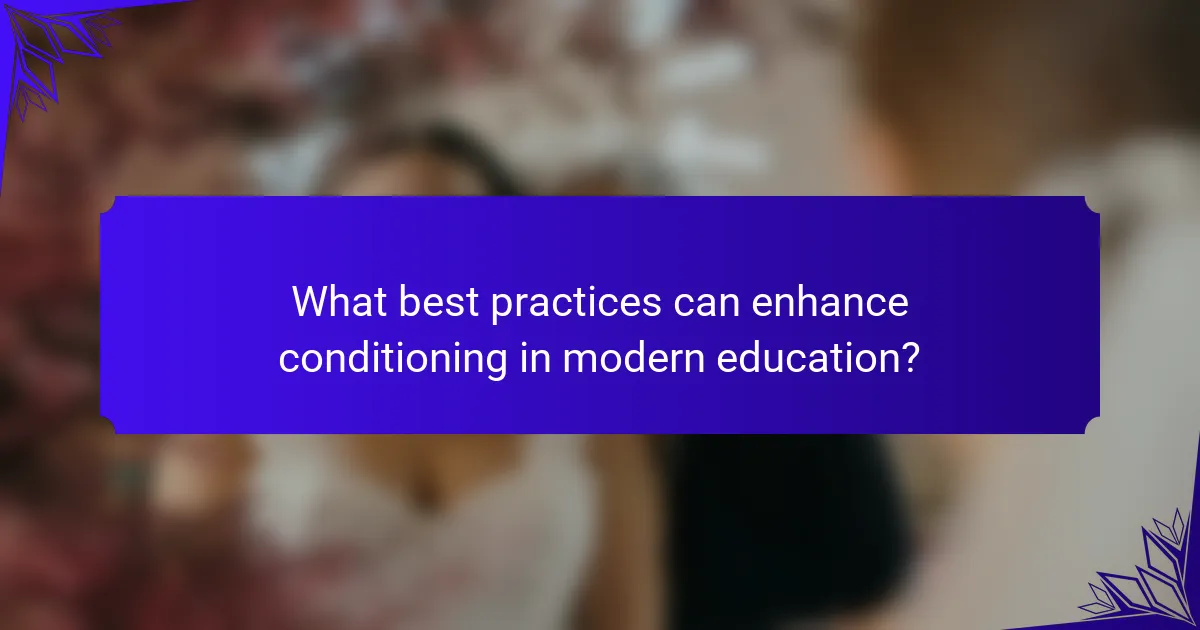
What best practices can enhance conditioning in modern education?
Integrating technology, neuroscience, and mindfulness enhances conditioning in modern education. Effective practices include utilizing adaptive learning technologies, applying neuroscience insights for brain-based learning strategies, and incorporating mindfulness techniques to improve focus and emotional regulation.
Adaptive learning technologies personalize educational experiences, catering to individual learning paces and styles. Neuroscience research emphasizes the importance of spaced repetition and active engagement, which can significantly boost retention and understanding. Mindfulness practices cultivate a conducive learning environment by reducing stress and enhancing cognitive flexibility.
By blending these approaches, educators can create a holistic framework that supports deeper learning and improved educational outcomes.
How can educators effectively measure learning outcomes?
Educators can effectively measure learning outcomes by integrating technology, neuroscience, and mindfulness practices. Utilizing data analytics tools allows for real-time assessment of student progress, while neuroscience insights inform tailored instructional strategies. Mindfulness techniques enhance focus, potentially improving retention and comprehension. Regular feedback loops foster an adaptive learning environment, ensuring that teaching methods align with student needs.
What common mistakes should be avoided in implementing new learning technologies?
To successfully implement new learning technologies, avoid common mistakes such as neglecting user training, failing to align technology with educational goals, and underestimating the importance of feedback.
Neglecting user training can lead to poor adoption rates, hindering the technology’s effectiveness. Aligning technology with educational goals ensures that the tools enhance learning rather than distract from it. Underestimating feedback can prevent necessary adjustments, limiting the technology’s potential to meet learners’ needs.
Additionally, overlooking integration with existing systems can create barriers, while ignoring user engagement may result in diminished motivation. Lastly, failing to evaluate the technology’s impact can hinder future improvements.
How can continuous professional development support educators in adopting new methodologies?
Continuous professional development equips educators to adopt new methodologies by enhancing their understanding of innovative practices. This approach integrates technology, neuroscience, and mindfulness, fostering an intuitive perspective on learning.
Educators benefit from ongoing training that emphasizes adaptive learning techniques, allowing them to respond effectively to diverse student needs. Research indicates that incorporating neuroscience principles can improve retention and engagement, making lessons more impactful.
Mindfulness practices help educators manage stress, promoting a positive learning environment. As a result, educators are better prepared to implement new methodologies that align with contemporary educational demands.
Ultimately, continuous professional development supports educators in creating dynamic, responsive classrooms that leverage the latest insights in learning science.
